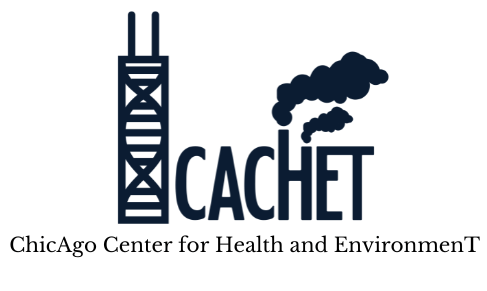RMG/Southside Recycling Permit Application and the Imperative to Deny the Permit
EPA Environmental Issues in Southeast Chicago
Air Pollution
 Array of Things initiative, a joint effort by UofC and Argonne National Lab, and supported by the City of Chicago, is currently collecting environmental information on air pollution in addition to light intensity, precipitation, air quality, heat, sound volume and foot traffic through decorative sensors on traffic poles throughout the City of Chicago. The result is a system that collects data about the City at the micro level, including fine-grained pollution levels in different neighborhoods. CACHET investigators have been collaborating with the AoT leadership to install monitors in relevant study areas in Chicago. The diversity of pollutants measured, the volume of monitors across the City (>350), the availability of a complimentary sensor for indoor measures, provides an unprecedented opportunity to more accurately assess exposure to air pollution and to understand the relative impact of air pollution in Chicago.
Array of Things initiative, a joint effort by UofC and Argonne National Lab, and supported by the City of Chicago, is currently collecting environmental information on air pollution in addition to light intensity, precipitation, air quality, heat, sound volume and foot traffic through decorative sensors on traffic poles throughout the City of Chicago. The result is a system that collects data about the City at the micro level, including fine-grained pollution levels in different neighborhoods. CACHET investigators have been collaborating with the AoT leadership to install monitors in relevant study areas in Chicago. The diversity of pollutants measured, the volume of monitors across the City (>350), the availability of a complimentary sensor for indoor measures, provides an unprecedented opportunity to more accurately assess exposure to air pollution and to understand the relative impact of air pollution in Chicago.
Airborne Metal Exposure
The far southeast side of Chicago, near the Indiana border, is one of the most polluted regions in the U.S. from steel production, metal recycling and petroleum refineries. Recently, there has been a great deal of public and community concern around pollution from storage of residual Petcoke in uncovered containers in this community. In addition, the EPA has identified high levels of airborne metals, especially manganese. It is not clear how much of the airborne pollution is from Petcoke or from local metal recycling plants. To date, there have been no studies of health effects from these exposures in the Southeast Chicago community. In response to neighborhood concerns, the UIC group is conducting a pilot study to examine toenail metals in local community and less affected community schoolchildren, relating the toenail levels to pulmonary function and school achievement. They have been working in collaboration with the Southeast Environmental Task Force (SETF): http://setaskforce.org/
Lead in Chicago Water
In recent years, concerns about lead contamination in the water supply in Chicago has resurfaced as an important environmental health issue. In a peer-reviewed study, researchers at the U.S. Environmental Protection Agency found alarming levels of the brain-damaging metal can flow out of household faucets for years after construction work disrupts service lines that connect buildings to the city’s water system. As nearly 80 percent of the properties in Chicago are hooked up to service lines made of lead, this has led to concern that residents may be increasing exposed to harmful levels of lead exposure as construction projects across the City are pursued. CACHET investigators are actively involved in understanding the potential public health impact of lead exposure from drinking water on Chicagoan health.
Drinking water study:
